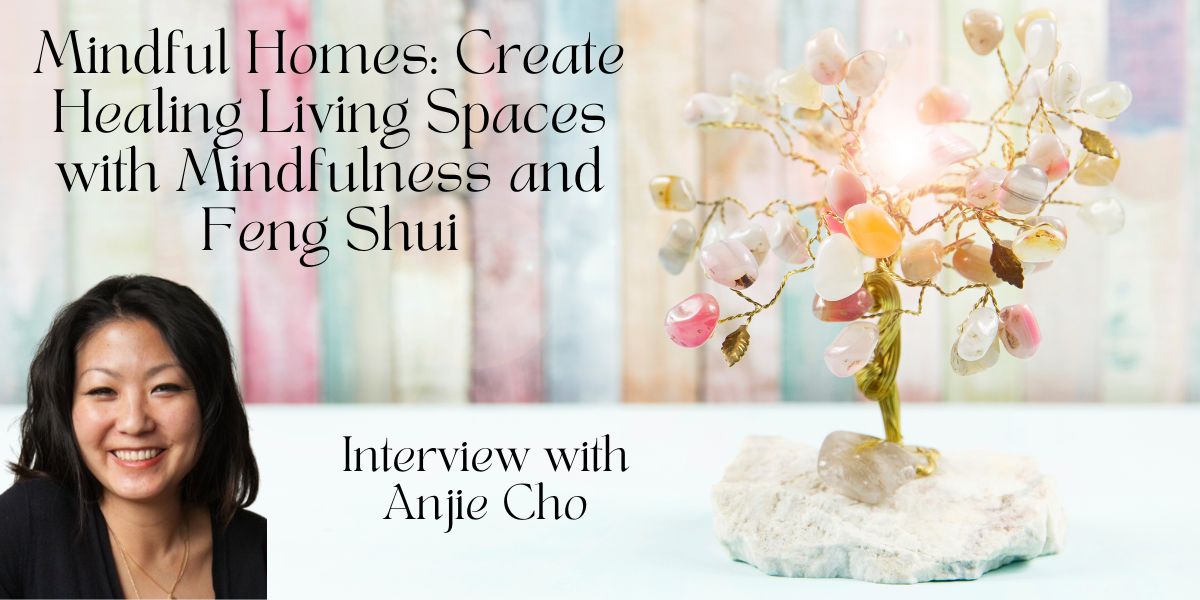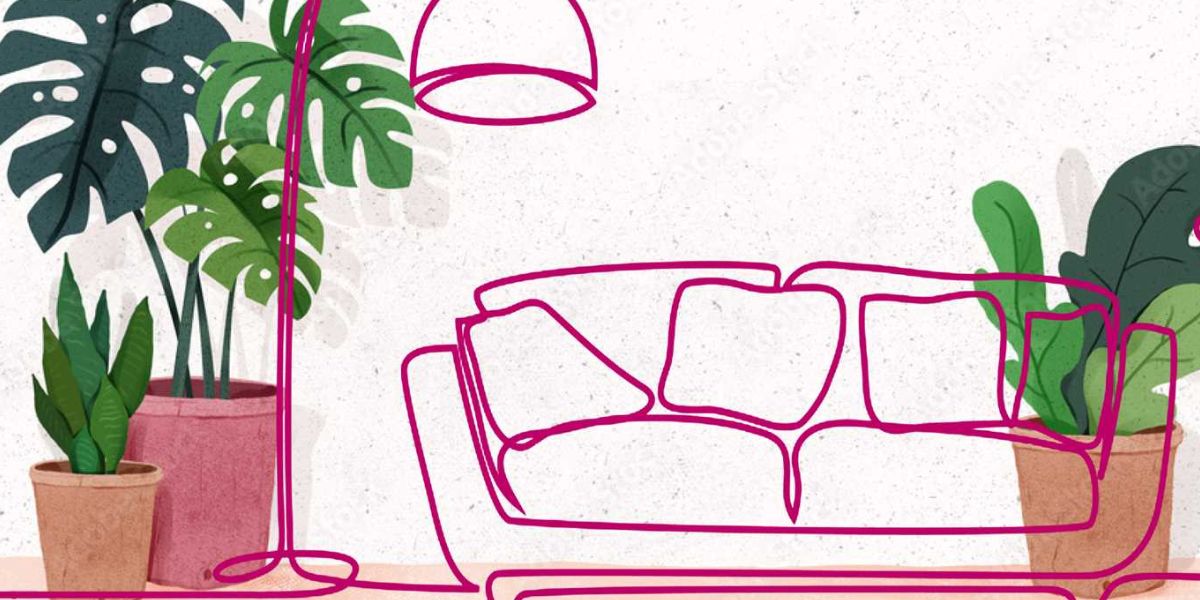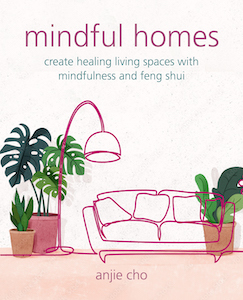
Anne: Hello, Anjie! Thank you so much for taking the time to speak with me about your newly released book Mindful Homes: Create Healing Living Spaces with Mindfulness and Feng Shui (CICO Books 2023). I really enjoyed it and have already used many of the concepts to rearrange space in my own home. For those who might not know much about feng shui though, would you share a bit about it?
Anjie: Hi Anne, so nice to meet you. And thank you so very much for including me on your blog Musing Mystical!
In a nutshell, what is feng shui? Feng shui is a healing modality that comes from China that looks at the flow of qi (life force energy) in you and your spaces. My personal definition is slightly different. Feng shui is a mindfulness practice that invites you to explore the world around you. It’s about paying attention to the details of your environment, without judgment, and seeing that we are interconnected and interdependent with our spaces.
Anne: Feng shui has been an interest of mine for quite some time, though I admit I get overwhelmed by the details sometimes. Your book really helped me to get out of my mind though and feel into the energy. How were you first introduced to feng shui? What do you believe attracted you to it? I’m curious as to what was going on in your life at the time. Were you instinctively incorporating feng shui into your life without realizing it?
Anjie: In my late twenties, during my Saturn return, I found myself looking at what was no longer working in my life. I was depressed, and felt resigned to the agonizing belief that all there was to life was getting up and going to a job that depleted me. I had an epiphany during my first reiki session while I was visiting Thailand. I realized that I needed to make a big shift, to make a big turn. I started studying meditation and yoga, which led me to have curiosity about how I could bring more depth and meaning in what I spent most of my waking hours doing– work!

I was working in architecture, so I looked at feng shui. I took some classes and then for years started eyeing the three-year certification program that I ended up graduating from. It was only when I had another opportunity to make another turn in my life, during the last big recession, where I took that plunge. This was one of the first times in my life that I invested in something with no expectations and no desired outcome. I just knew my heart leapt with joy when I learned more and more about the profound practice of feng shui. Then my whole world started opening up. I never had any aspirations to write a book (let alone two!), teach, be any sort of public figure, etc. I just thought I’d be working for an architecture firm my whole life. So yes, I just followed the path laid out for me and it led me to feng shui.
Anne: You write that one should approach creating more aligned spaces beginning with intuition. I totally get that and use it for myself. But, when I get to the more technical aspects of feng shui, like using the bagua, my eyes glaze over and I throw my hands up and throw in the towel. These technicalities turn me off. Is there hope if I don’t follow most of the “typical” tenets of feng shui?
Anjie: Everyone has intuition, but that doesn’t mean everyone has cultivated skills and wisdom of any practice (like feng shui, or meditation, or creating a loaf of bread, or playing piano). It requires a bit of elbow grease 🙂 If the technicalities throw you off, then feng shui is probably not your thing. Just like I have no interest in making my own bread, it’s not my thing. One would not just say, well intuitively I know how to play piano…. It’s important to have some respect and cultural appreciation of practices and ancient wisdoms. At the same time, I wrote my new book Mindful Homes with newbies in mind who do throw in the towel when they get confused. It’s part of my life path, and I feel it’s also part of my responsibility to share feng shui teachings in a way that is digestible. But that said, it’s totally ok to throw in the towel! I think the important thing is to be respectful and not say that you know feng shui when you have not practiced.
Anne: That makes a lot of sense! I loved the themes of interconnectedness and interdependence that ran through the book. I also found it refreshing and liberating to read that I was released from fixing a space or even myself. Can you describe your unique “turnaround approach” when most view as feng shui being a “fix” to imperfection? Do you feel that most feng shui teachings focus on fixing versus unfolding of one’s true nature in one’s physical and non-physical spaces?
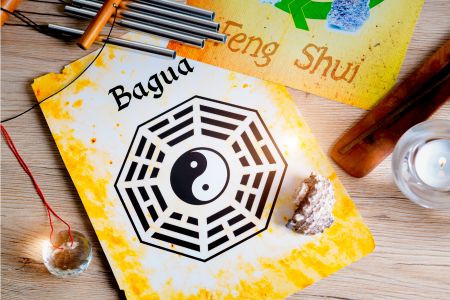
Anjie: I think most of the western world as a whole is geared to a fix it approach. It’s not unique to feng shui. We think a pill, money, or a lot of “Likes” will make us happy, when really there’s much to look at underneath the surface. I don’t follow feng shui practitioners except my students and teachers. This teaching of interconnectedness, interdependence, becoming friendly with yourself, are within Buddhist and Taoist dharma teachings that are the underlying foundation of feng shui. Most things on a superficial level are about fixing. And that’s ok. My new book Mindful Homes is an invitation to take it a step deeper and offer what I have found helpful in my life. So, others can teach or practice feng shui as they wish. They can live life as they wish. And it’s all included.
Anne: How do you work with a living space that seems to be completely at odds with feng shui such as weird floor plans, stairways that can’t be moved for optimal feng shui benefit, etc.
Anjie: I teach that even if something has challenging feng shui, it might be helpful for that person. Sometimes we are attracted to homes that may open us up to or even exacerbate a situation because we are at the place to work with it. It’s workable. So with any floor plan or client, it’s all workable. When I work with a client and their space, it’s a 1-1 connection so it’s hard to say what I would do, because each situation, each space, each moment, each request is different. Just like we are all different.
Anne: It seems that creating healing spaces begins with noticing – noticing your feelings to something, your reactions, your “gut” response. I liked how you mentioned simple things like noticing your plants – have they outgrown a pot, are their leaves dusty. Is intentional noticing or honoring what your body is noticing through intuition, at the basis of feng shui?
Anjie: Sometimes this can be a part of feng shui as I’ve suggested in my book. I don’t know if others practice this way or would necessarily agree. It’s just one of the many tools in the toolbox. There’s an invitation to see the world as non-binary. It doesn’t have to be yes/no good/bad black/white or this is feng shui, this isn’t.
Anne: What do you feel is the difference between feng shui and decluttering? Can you have an optimal dwelling space, whether internally or externally, with a lot of “things” in that space be it furniture or thoughts?

Anjie: When feng shui was developed, there was no such thing as clutter. Clutter is a modern-day dilemma. And a feng shui practitioner does not have the same skills as a Professional organizer. I have zero experience in helping someone declutter their space.
And yes, of course, one can have a lot of things in a space and it can be perfect for them.
Anne: The book stretched the concept of feng shui for me in a way that created a great expanse. The section on space that also touched on manipulating and stretching time was a bit mind blowing. As was the focus not only on external spaces but also our internal spaces as well. You recommend a daily meditation practice. Can you briefly describe how such a practice creates a mindful inner space? Do you feel that feng shui, along with meditation, are an ongoing practice instead of a one-and-done effort?
Anjie: I don’t know how to describe the indescribable. And I think it would be a disservice to do so. When I teach my students, and when you read my book, you’ll see there’s a large focus on your own experience. This is why meditation practice is so helpful. No one can tell you what your experience is in meditation, no matter how many words you put to it. And no one will ever understand you. But I’ve found, as a meditation practitioner, my most meaningful and helpful moments have been a direct result of sitting in silence with myself. For instance, I can do a whole meditation retreat with a stranger, never say a single word, and yet we have created a space and walked a journey together. And afterwards we don’t need to talk about the details, yet we know we have experienced a meaningful inner space together.
So, I would say, I can’t tell you or describe it. I would just recommend you practice it.
And for my students and myself, we see feng shui as a lifelong practice, study, and lifestyle. It’s a philosophy that trickles into every part of life, just like we are always present IN physical spaces. Feng shui is the space around us. At the same time, it’s totally ok for someone to just try things, meditation or feng shui or scuba diving :), and decide it’s not for them!
Anne: One of my favorite aspects of Mindful Homes is how it includes ways to use crystals to enhance the space. How did you come to learn about crystals and the effects they have on one’s space?
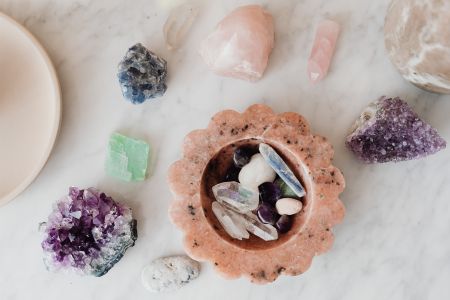
Anjie: We all live on this planet earth. We walk on the earth. Crystals or even ordinary stones, come from the earth. It’s something we all understand. Most of us learn at a very young age that a diamond is of great value, it sparkles, comes from the earth, it offers clarity. I learned about crystals from just having them around me, from what others taught me, books, and I especially love crystals in jewelry. I make malas, and love to wear gems and semi-precious stones and metals. But even an ordinary stone that you meet on a hike can be a teacher. Stones, rocks, gemstones have been on this earth much longer than humans. There’s much stillness and wisdom there. In my book I review how crystals can be connected to feng shui principles through color, meaning, or by listening to the stone itself.
Anne: You write that in feng shui, everything is alive, even our dwelling spaces as it’s filled with qi, the life force energy. You recommend that we name our dwelling spaces to reflect that qi. This reminded me of when I traveled to visit my husband’s family in England and I was struck that people named their homes. When they referenced going to someone’s house, they didn’t say “Let’s go to Marion’s house,” they said, “Let’s go to Sunnybrook,” the name of the house. How does one pick a good name?
Anjie: Oh yes, we do that in New York City, too. I didn’t think of that connection. There’s no good/bad name. And the name can always change. I think the key is to offer a name that arises from sincerity. Then it’s not necessary to judge it as good or bad. That said, if the word already has a lot of personal negative connotations for you, that might be something to pay attention to. I don’t think I’d want to be called “ugly” or “stupid”.
Anne: A few years ago, I was home for a few days and so spent a lot of uninterrupted time in my living space. I noticed new things like how beautiful the late afternoon light was in one room where I had been reading. I experienced a quiet early morning having coffee outside when I’d normally been hurrying to work. Your book’s section on an unscheduled day resonated. Can you talk about the benefits of having an unscheduled day at home?
Anjie: One benefit is receiving messages from the home. There may be something the home can tell you that you’ve been neglecting. It’s very easy to take our homes for granted, and sleepwalking through life. But the world has so many gifts to share if we can just open our eyes and heart.
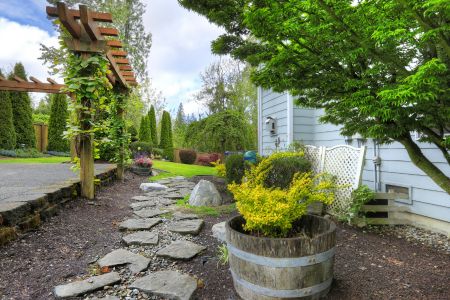
Anne: How does one incorporate the ideas in this book into one’s life if we share a space with others who are not so attuned or supportive of the changes we want to make? And you have recommendations for what to do if you don’t have disposable income to spruce up an outdoor space? For example, a house that lacks shutters or a space that is just dirt instead of lawn. What can you do if you are a renter and the space is not yours to decorate as you’d like?
Anjie: I recommend you only work on the spaces you are permitted to adjust. There should be some sort of consent from the other(s) that you share your spaces with. Or just make the shifts in the spaces that are yours. Same with renters, you can make the changes that are possible within the guidelines provided by your landlord. If you are staying in someone’s home, it’s not your home to change, but you can ask for permission if it’s something that you feel is important.
It’s a misconception that feng shui requires “disposable income.” For instance, if you want to bring a crystal into your home you can go out in nature and see if you find an ordinary stone that wants to come home with you. You can ask for permission and consent. If you get a yes, then you may take it home.
Always, I say you can only do the best you can with what you have. It’s not helping you to say “yes, but……” you’re only creating the blocks for yourself.
Anne: Wow, thank you so much for all this insight Anjie! You’ve given me so much food for thought as I continue to become more aware of my connection to the space around me in my home.
Anjie: You’re welcome! Thank you so much Anne!
For those whose interest is sparked by this interview, you can glean much more of Anjie’s wisdom in Mindful Homes: Create Healing Living Spaces with Mindfulness and Feng Shui (CICO Books 2023). I highly recommend it for those looking to spruce up their space and naturally shift the energy both within and around their home.
Anne Greco is a non-fiction writer who writes about her life experiences and travels with humor, keen observations, and the hope that her words will remind us that “we’re all just walking each other home.” Her book, Serendipity: Chance Pilgrimages, tells the story of Anne encountering her places of power. As she reconnects with herself at each site, Anne also develops a deeper understanding and appreciation of her connection to both the seen and unseen worlds. Learn more about her work here: http://annegrecowriter.com.
